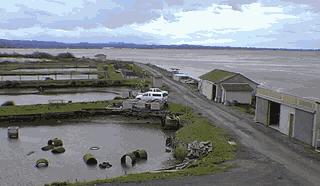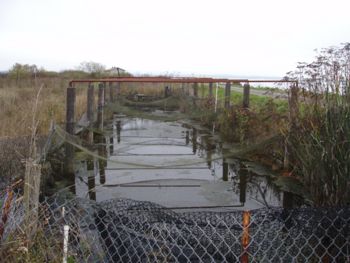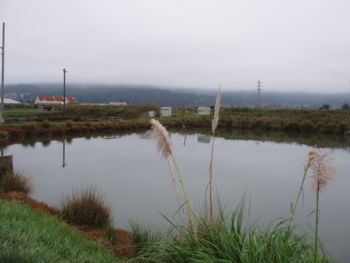General History
Aquaculture is the cultivation of marine or fresh water organisms in a controlled environment for scientific or buisness purposes.[1] A number of different kinds of marine life are culitvated all over the world, including oysters, clams, salmon, and trout. Aquaculture can be practiced as a low-technology extensive method to highly intensive system, with varying degrees of each.[1] Extenstive methods do not envolve a lot of change to the natural environment where the cultivation takes place and yield is usually low. On the other hand, intensive systems control many of the variables involved by cultivating the organisms in tanks or man-made ponds and this method usually produces a high yield.
Wastewater Aquaculture History

In the early 1960's Dr. George H. Allen, a professor at HSU, proposed to build the first recirculating salmonid hatchery in the United States. The salmonid hatchery was composed of different kinds of salmon, including coho, chinook, steelhead, and coastal cutthroat. He went on to become a specialist in wastewater aquaculture and teamed closely with the community to develop the Arcata Wastewater Aquaculture Project, which demonstrated the raising of salmon and cutthroat trout fry in a mixture of municipal wastewater and bay water.[2] In 1971 the aquaculture ponds were built in the north arm of Humboldt Bay. In the past, wastewater had never been used for salmonids due to their sensitivity to ammonia. With the incorporation of seawater, the ammonia's effect on the salmon was buffered.[3] Seawater also increased the dissolved oxygen levels and marine invertebrates for a source of food.[4]
Life Cycle of a Salmonid in the Aquaculture Pond


Research Completed in the Project
Over the years, Professor Allen and students in the fisheries department at HSU conducted experiments at the facility. In 1981, David Leonhardt conducted his master's thesis regarding the effectiveness of two interconnected waste water/sea water ponds for rearing salmon smolts. Fingerling coho salmon were raised at the Arcata Aquaculture Facility (AAF)and the Humboldt State University Hatchery. David concluded the smolts raised at the AAF showed higher survival, better growth, higher percentage of smoltification, and a higher return rate than the salmon raised at the HSU hatchery.[3] In the early 1980's Scott Johnson also did some research in correlation with his thesis. Scott researched how supplemental feeds promoted rapid growth of juvenile salmonids reared in the ponds. Three different diets were used in the experiment, each having different ratios of the crustacean Daphnia magna and fillet carcasses of dover sole.[5]One diet consisted only of dover sole, the second of only Daphnia magna, and the third was a mixture of both. Scott concluded that fish with the dover sole diet were quiet larger than fish with the other diets and it was an effective supplemental diet to fish reared in the wastewater ponds.[5]
Success in the Project
Over the last 30 years many conclusions have been made, as many experiments and research have been conducted at the Arcata Aquaculture Facility. The facility has been recognized as an ancillary benefit for the city of Arcata and the surrounding areas. Using wastewater in aquaculture ponds has increased the limited amount of clean drinking water for Humboldt County. The wastewater also provided a source of feed for the salmonid smolts decreasing the costs of the project. The aquaculture ponds have also helped increase return rates of the salmonids and trout. Being the first wastewater aquaculture facility in the country, the Arcata Wastewater Facility has been an example and reference for other cities and countries who want utilize this project.
Current Status
Even though the project was a success, a number of events led to the termination of the project in January of 2008. In the late 1990's George Allen retired from the project and soon afterward fish where no longer reared at the facility.Dr. Karen Brenneman, a microbial ecologist, took his place as the wastewater utilization specialist. Dr. Brenneman's lack of specific knowledge to the project contributed to it's demise. Through the 37 years of its existence, insufficient funds supported the wastewater aquaculture project and by the 1990's Arcata's Wastewater Treatment Center could no longer run the facility.
References
- ↑ 1.0 1.1 Answers. Accessed 10/18/08. http://www.answers.com/topic/aquaculture
- ↑ Fisheries Dedication Honors Allen, Scott. The Eureka Reporter. April 27,2008. Accessed on 10/21/08.http://www.eurekareporter.com/article/080427-fisheries-dedication-honors-allen-scott
- ↑ 3.0 3.1 Leonhardt, David. Evaluation of a Two Unit Wastewater-Seawater Pond System for Rearing of Juvenile Coho Salmon, Oncorhynchus Kisutch. Thesis presented to HSU. Arcata, CA 1984
- ↑ City of Arcata. A Visit to the Aquaculture Facility. 1990
- ↑ 5.0 5.1 Johnson, Scott. Daphnia Magna and Fish Processing Wastes as Supplemental Feeds for Juvenile Salmonids in Wastewater. Thesis presented to HSU. Arcata, CA. 1981
<layout name="Project" />